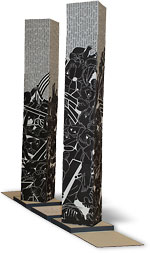Nation Building
Jefferson’s omnivorous mandate has led Dimunation to make some adventurous—and impressive—acquisitions. Last fall, through a dealer, the library bought a rare first edition of Starry Messenger, the 1610 book in which Galileo announced his observation of the moon using a telescope. “It’s a small publication that completely changed the world. And ours is a really lovely, and—lovely is not even the right word—ours is a really spectacular copy. When we actually sat down to look at it the room just fell absolutely silent.”
Jefferson’s sensibility continues to guide acquisitions at the library.
Rare does not always mean old, of course. Marshall Weber, an artist and head curator for Booklyn Artists Alliance in New York, has known Dimunation since he and fellow book artist Christopher Wilde visited the rare books chief shortly after he started at the Library of Congress. They tried to interest him in buying their one-of-a-kind creations.
Dimunation’s initial response, says Weber, was, “This isn’t even a book. It’s a piece of art.” But the discussion about whether a unique book is a valid form of American publishing didn’t end there, says Weber, and years later Dimunation changed his policy. “Mark is interesting as a curator because he functions in the fullest definition of that word,” Weber says. “He’s not just buying things. He’s deeply involved in the dialogue around the history of the American book…. When the field is changing, he will be the first person to take the risk to make the change.”
Last year through Booklyn Dimunation purchased a limited-edition portfolio, produced by the collaborative known as the Combat Paper Project, that consists of sheets of paper made from an Iraq War vet’s shredded combat uniform; depicted on them are images of the soldier removing his uniform and cutting it. You might wonder, says Weber, “How can the federal government collect something like that, that’s so critical?” But the ultimate goal of preserving American history means that political orthodoxy doesn’t rule the library’s acquisitions—and that what tomorrow’s users of the library will be interested in is as important a consideration as what today’s users want to see.
Artist books such as this one and others—including a piece Dimunation bought from Werner Pfeiffer commemorating 9/11 that can be constructed into a three-dimensional model of the twin towers—are “the perfect intersection between contemporary issues and contemporary book arts,” says Dimunation.
While he loves books, Dimunation doesn’t exhibit the fussy obsessiveness of a born collector. He fell into curatorial work while a graduate student at the University of California at Berkeley, where he took a job in the library while working toward a Ph.D. after earning a master’s in American history. He never finished the doctorate, but he did discover an abiding love for working with rare books. He moved on to serve as assistant chief of special collections at Stanford before landing at Cornell in 1991.
Dimunation’s gift for showmanship—for “interpreting things and bringing things to life,” says Tabb—make him a valuable ambassador for the nation’s library, and equip him to solicit donors, a particularly important skill at a place that does not have an alumni network to fall back on (unlike the great research libraries at Ivy League universities and other academic institutions). Katherine Reagan, curator of rare books and manuscripts at Cornell and a close personal friend, notes Dimunation’s oratorical gifts as well. “Nowhere will you encounter a more entertaining public speaker, a fact widely demonstrated by his busy international lecture schedule.”
For the past several years, Dimunation has used his pedagogical talents to team-teach a popular class on the history of the book at the Rare Book School at the University of Virginia. During our conversation, he more than once took a smooth detour to explain a word he thought might be unfamiliar or spell out a title he wasn’t sure I’d know, without seeming in the least condescending.
His sense of humor is apt to surprise visitors who expect a stuffy shush-er. Tabb recalls bringing some friends to the Library of Congress’s rare books reading room, where Dimunation greeted them with the mock warning, “You’re going to see books that you want to touch, but if you do touch them, I’ll cut your hands off.”
On our own tour of the library, as Dimunation took one book after another down from the shelf to show me, he was reverent but not ginger, his years of handling materials that others itch to touch lending him a casual confidence. He has a habit of pushing his glasses up on his forehead, rather like Christopher Lloyd does with his goggles as the zany scientist Doc in Back to the Future. Gesturing enthusiastically, he delivered a steady stream of information about the books around us.
We ended up in the dim room where Jefferson’s collection is on permanent display in a circular set of glassed-in bookshelves. People wearing T-shirts and fanny packs roamed the room. A boy in a wheelchair sat in front of an electronic screen that explained the exhibit.
Dimunation’s patter subsided. Then he said, “It always makes me—”
“What?” I had to prompt him.
“It makes me teary when I see all these people in here.”








